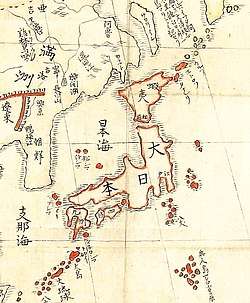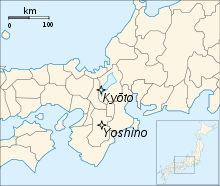Bunchū
Bunchū (文中) was a Japanese era name (年号, nengō, lit. year name) of the Southern Court during the Era of Northern and Southern Courts after Kentoku and before Tenju. This period spanned the years from October 1372 to May 1375.[1] The Southern Court emperor in Yoshino during this time-frame was Emperor Chōkei (長慶天皇, Chōkei-tennō). The Northern court emperor in Kyoto was Emperor Go-En'yū (後円融天皇, Go-En'yū-tennō).[2]
| History of Japan |
|---|
 |
Nanboku-chō overview
During the Meiji period, an Imperial decree dated March 3, 1911 established that the legitimate reigning monarchs of this period were the direct descendants of Emperor Go-Daigo through Emperor Go-Murakami, whose Southern Court (南朝, nanchō) had been established in exile in Yoshino, near Nara.[3]
Until the end of the Edo period, the militarily superior pretender-Emperors supported by the Ashikaga shogunate had been mistakenly incorporated in Imperial chronologies despite the undisputed fact that the Imperial Regalia were not in their possession.[3]
This illegitimate Northern Court (北朝, hokuchō) had been established in Kyoto by Ashikaga Takauji.[3]
Change of era
- 1372, also called Bunchū gannen (文中元年): The new era name was created to mark an event or series of events. The previous era ended and the new one commenced in Kentoku 3.[4]
In this time frame, Ōan (1368–1375) was the Southern Court equivalent nengō.[4]
Events of the Bunchū Era
- 1372 (Bunchū 1): Shōgun Ashikaga Yoshimitsu establishes an annual revenue for Iwashimizu Hachiman-gū.[4]
- 1373-1406 (Bunchū 2 – Ōei 13): Embassies between China and Japan.[5]
- 1374 (Bunchū 3): The former Emperor Go-Kōgon died at age 73,[6]
- 1374 (Bunchū 3): Emperor Go-En'yū ascends northern throne.[5]
Notes
- Nussbaum, Louis-Frédéric. (2005). "Bunchū" in Japan encyclopedia, p. 90; n.b., Louis-Frédéric is pseudonym of Louis-Frédéric Nussbaum, see Deutsche Nationalbibliothek Authority File.
- Titsingh, Isaac. (1834). Annales des empereurs du japon, pp. 310-312.
- Thomas, Julia Adeney. (2001). Reconfiguring modernity: concepts of nature in Japanese political ideology, p. 199 n57, citing Mehl, Margaret. (1997). History and the State in Nineteenth-Century Japan. p. 140-147.
- Titsingh, p. 310.
- Ackroyd, Joyce. (1982) Lessons from History: The "Tokushi Yoron", p. 329.
- Titsingh, p. 311.
References
- Ackroyd, Joyce. (1982) Lessons from History: The Tokushi Yoron. Brisbane: University of Queensland Press. ISBN 978-0-7022-1485-1
- Mehl, Margaret. (1997). History and the State in Nineteenth-Century Japan. New York: St Martin's Press. ISBN 978-0-312-21160-8; OCLC 419870136
- Nussbaum, Louis Frédéric and Käthe Roth. (2005). Japan Encyclopedia. Cambridge: Harvard University Press. ISBN 978-0-674-01753-5; OCLC 48943301
- Thomas, Julia Adeney. (2001). Reconfiguring Modernity: Concepts of Nature in Japanese Political Ideology. Berkeley: University of California Press. ISBN 978-0-520-22854-2; OCLC 47916285
- Titsingh, Isaac. (1834). Nihon Odai Ichiran; ou, Annales des empereurs du Japon. Paris: Royal Asiatic Society, Oriental Translation Fund of Great Britain and Ireland. OCLC 5850691
| Preceded by Kentoku |
Era or nengō Bunchū 1372–1375 |
Succeeded by Tenju |
